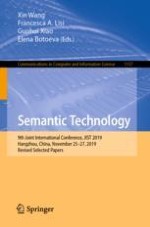2020 | Buch
Semantic Technology
9th Joint International Conference, JIST 2019, Hangzhou, China, November 25–27, 2019, Revised Selected Papers
herausgegeben von: Xin Wang, Dr. Francesca A. Lisi, Guohui Xiao, Elena Botoeva
Verlag: Springer Singapore
Buchreihe : Communications in Computer and Information Science
